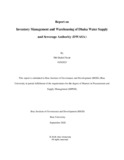| dc.contributor.advisor | Mahmud, Md. Elias Uddin | |
| dc.contributor.advisor | Islam, Mohammad Sirajul | |
| dc.contributor.author | Nazir, Md Shahid | |
| dc.date.accessioned | 2021-07-07T07:47:24Z | |
| dc.date.available | 2021-07-07T07:47:24Z | |
| dc.date.copyright | 2020 | |
| dc.date.issued | 2020-09 | |
| dc.identifier.other | ID 18282023 | |
| dc.identifier.uri | http://hdl.handle.net/10361/14751 | |
| dc.description | This dissertation is submitted in partial fulfillment of the requirements for the degree of Masters in Procurement and Supply Management, 2020.. | en_US |
| dc.description | Cataloged from PDF version of dissertation. | |
| dc.description | Includes bibliographical references (pages 23-24). | |
| dc.description.abstract | Dhaka Water Supply and Sewerage Authority (DWASA) is a service oriented autonomous commercial organization in the public sector. Its main responsibility is to provide safe drinkable water to Dhaka city dwellers. Apart from water supply, DWASA is also responsible for drainage, sewerage system operation and maintenance, and other treatment plants under its jurisdiction. Though DWASA is a profitable public organization, but never achieved its ultimate target as expected because of corruption and inefficient system and procedures. But in recent times DWASA has been trying to focus all areas where automation and digitization can bring ultimate quality management. Previously, consumer billing system was fully manual paper-based, so bill collection never achieved at its desire level. By implementing digital billing system DWASA’s bill collection increased in significant level, hence DWASA earns higher percentage of revenue compared to early years. Consequently, senior management expects every activity has to be automated to ensure efficiency everywhere. From 2017 DWASA also developed software based online inventory management system and Radio-frequency identification (RFID) is the latest inclusion. This report is based on present situation of store division of DWASA. The major responsibilities of store division are inventory management, warehousing and quality management of materials. By using store online inventory software report, senior management is able to know the present condition of inventory, forecasted demand, usage history of other divisions, total consumption report, even unused or wastage materials that could be repairable or actionable. Previously, no such report has published and sometimes senior management is not aware of the actual scenario. So, situation has changed dramatically after implementation of information technology and developing the inventory software and latest RFID technology. At present there are lots of academic research papers are available and best practices to achieve expected results. But it is really hard to implement those sophisticated technology because of organizational culture and internal conflicts. The report has structured by chapters. Chapter 1 describes the overview of the organization, chapter 2 presents the practices of inventory management of Dhaka WASA, chapter 3 describes the warehouse functions and finally in chapter 4 has some recommendations. | en_US |
| dc.description.statementofresponsibility | Md Shahid Nazir | |
| dc.format.extent | 24 pages | |
| dc.language.iso | en | en_US |
| dc.publisher | Brac University | en_US |
| dc.rights | Brac University dissertations are protected by copyright. They may be viewed from this source for any purpose, but reproduction or distribution in any format is prohibited without written permission. | |
| dc.subject | Inventory management system | en_US |
| dc.subject | Inventory software | en_US |
| dc.subject | Store division | en_US |
| dc.subject | Warehouse management | en_US |
| dc.subject | Annual procurement plan | en_US |
| dc.subject.lcsh | Inventory control. | |
| dc.subject.lcsh | Business and Management. | |
| dc.title | Inventory Management and Warehousing of Dhaka Water Supply and Sewerage Authority (DWASA) | en_US |
| dc.type | Dissertation | en_US |
| dc.contributor.department | Brac Institute of Governance and Development, Brac University | |
| dc.description.degree | M. Procurement and Supply Management | |

